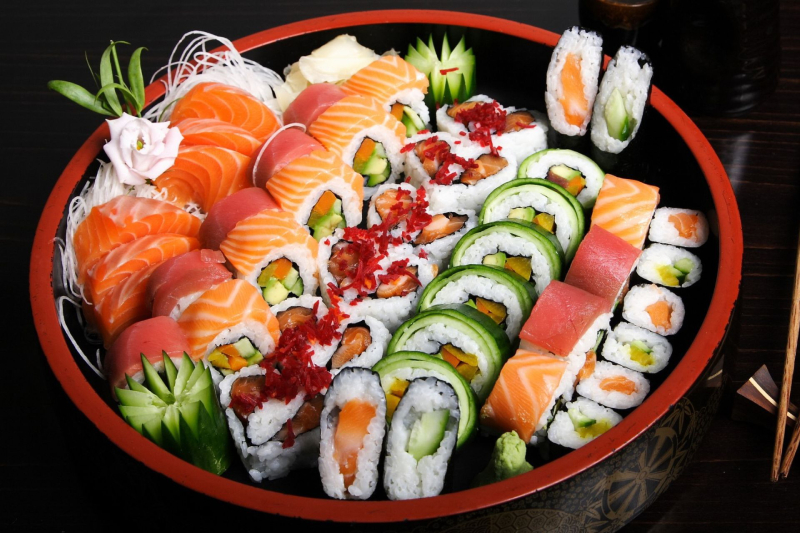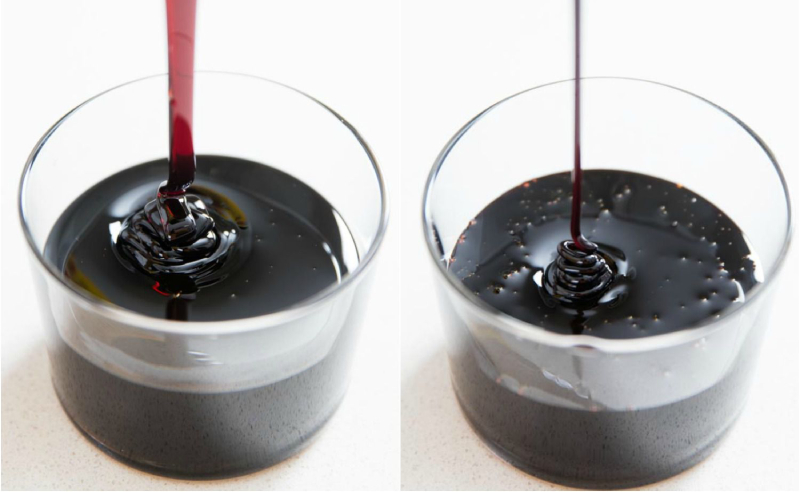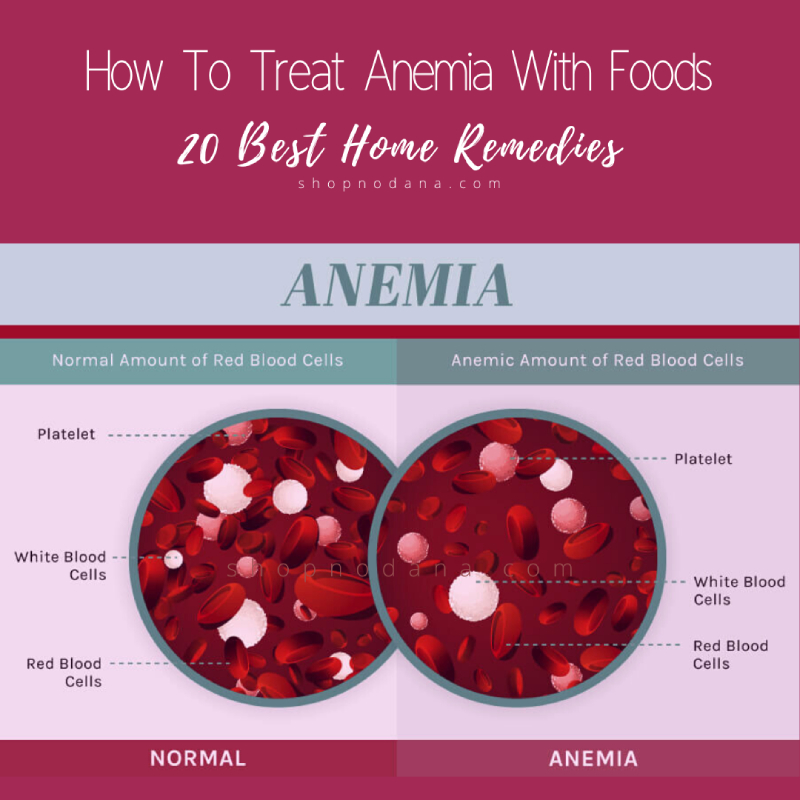How To Treat Anemia With Foods- 20 Best Home Remedies
How To Treat Anemia? Are there any home remedies to get relief from this condition? Well, in this article you will know the best home remedies to treat Anemia at home. Do you feel constant fatigue? Or is your skin looks dull and pale recently? Comfort may not be all you need.
Anemia is a condition in which your body is low in red blood cells. Healthy red blood cells are the main part of the hemoglobin in your blood that binds oxygen.
Anemia is a condition that occurs when the number of red blood cells in the body is less than normal or red blood cells do not contain the required amount of hemoglobin. About 3 million Americans suffer from anemia.
Hemoglobin is an iron-based protein that helps blood cells carry oxygen to different parts of the body. When you have anemia, your blood will not be able to provide the proper oxygen supplies to the organs and tissues.
According to the World Health Organization, males with less than 13 grams of hemoglobin per deciliter have anemia. For women, the standard is less than 12 grams of hemoglobin per deciliter. [1]
Causes and Types of Anemia
Anemia can be caused by:
- Blood cell loss due to excessive bleeding
- Pregnancy, during which your body needs more than the normal amount of iron to support your child’s development
- Low iron absorption, which can be the result of chronic health conditions such as Crohn’s disease, cancer, HIV / AIDS, celiac disease, or weight loss surgery
- When the body does not produce enough red blood cells due to nutrient or iron deficiency (anemia due to iron deficiency caused by iron deficiency; pernicious anemia caused by poor absorption of vitamin B12 or folic acid from the diet)
- When the body destroys many red blood cells (hemolytic anemia)
- Inheriting a type of disease that can distort the shape of red blood cells to the shape of a sickle crescent (sickle cell anemia)
- Latent bone marrow diseases such as leukemia or spinal cord inflammation affect the bone marrow’s ability to manufacture blood cells (aplastic anemia)
Signs and Symptoms of Anemia
Anemia is a result of fewer red blood cells that contain hemoglobin. A lack of this oxygen-carrying protein can disturb oxygen levels in parts of the body, forcing the heart to work harder to pump blood Thus, fatigue and tiredness come as obvious symptoms.
Mild anemia may go unnoticed for years and may come to notice only when it has taken a severe form.
Other symptoms that can indicate anemia include:
- Paleness
- Shortness of breath
- You may feel changes in your body temperature or feel cold feet and hands
- Headaches
- Irregular or uneven heart palpitations
- Cognitive problems such as brain fog
- Severe hair fall and brittle nails
- Dizziness and loss of stability
- Lack of energy
- Being moody or feeling low all the time can be your regular symptom.
Diagnosing Anemia
To diagnose anemia, your doctor will likely ask you about your medical and family history, perform a physical examination, and perform the following tests:
Complete blood count (CBC)
CBC is used to count the number of blood cells in a blood sample. For anemia, your doctor will be interested in the levels of red blood cells in your blood (hematocrit) and hemoglobin in your blood.
Adult normal hematocrit values differ between medical practices but range from 40% to 52% for men and 35% to 47% for women. In adults, hemoglobin values are usually between 14 and 18 grams per deciliter for men, and 12 to 16 grams per deciliter for women(2).
A test to determine the size and shape of red blood cells
Some red blood cells may also be examined for unusual size, shape, and color.
Additional diagnostic tests
If you receive a diagnosis of anemia, your doctor may order additional tests to determine the cause. Sometimes, it may be necessary to study a bone marrow sample to diagnose anemia.
How to Treat Anemia With Foods
Treatment for anemia depends on the causative agent. Although the condition requires long-term monitoring and treatment.
Generally, young people tend to recover faster than older adults. Older people may have major effects on their bodies as a result of basic medical conditions.
Anemia can be treated with various approved medical prescriptions, such as:
- Iron supplement in case of anemia due to iron deficiency. Iron infusions can be given intravenously in severe cases.
- Vitamin B12 infusions.
- Following a diet strictly adheres to nutritional needs in order to overcome the causing folic acid, vitamin B12, and iron deficiency.
- Avoid foods that can interfere with food absorption.
- Eat foods rich in iron, vitamin C and B12:
- Include lentils and whole grains in your diet.
- Include fresh fruits and vegetables in your diet.
- Avoid sugar, processed grains, bran, and soda.
- Reduce consuming tea, coffee, dairy products, and dark chocolate.
Natural Remedies for Anemia- How to Treat Anemia Naturally
You can easily treat and prevent some types of anemia at home with some ingredients in the kitchen cupboard.
Let’s dissect nutrients that can serve as a home remedy to optimize hemoglobin levels.
1. Add Meat and poultry to your diet
All meat and poultry contain heme iron. Red meat, lamb, and deer are the best sources. Poultry and chicken have fewer quantities. Eating meat or poultry with non-ferrous foods such as leafy greens can increase iron absorption
2. Seafood
Some seafood offer heme iron. Oysters such as oysters, oysters, and shrimp are good sources. Most fish contain iron. Iron-containing fish include:

- Oiled sardines
- Canned or fresh tuna
- Try to get Fresh salmon
- Fresh halibut
- Eat Fresh perch
- Fresh haddock
Although both fresh and canned salmon is a good sources of iron, canned salmon is rich in calcium.
Calcium is bound to iron and reduces its absorption. Foods that are high in calcium should not be eaten at the same time as foods rich in iron.
Other examples of calcium-rich foods include:
- Raw milk
- Yogurt
- kefir
- cheese
- Sardines
- Broccoli
- Tofu
3. Fortified foods
Many foods are fortified with iron. Add these foods to your diet if you are a vegetarian or are struggling to eat other sources of iron:
- Fortified orange juice
- Ready-to-eat fortified cereals
- Foods made with fortified refined flour such as white bread
- Fortified noodles
- Food made from fortified cornmeal
- Fortified white rice
4. Nuts and seeds
Many types of nuts and seeds are good sources of iron. They taste food alone or sprinkle on salad or milk. When choosing nuts and seeds, choose raw varieties whenever possible. Some of the nuts and seeds that contain iron are:
- pumpkin seeds
- Cashew nuts
- pistachio
- Hemp seeds
- Pine nuts
- Sunflower seeds
Almonds are also a good source of iron. It’s great as part of a healthy eating plan, but since it also has a high calcium content, your iron levels may not increase much.
5. Include beetroot in your diet
Beetroot is very useful for those who suffer from iron deficiency anemia, which is most common among all types of anemia. It is high in iron, along with fiber, calcium, potassium, sulfur, and vitamins. [3] [4]
In addition to providing nutrition, beets help cleanse the body and provide more oxygen throughout the body. This, in turn, helps to increase the number of red blood cells in the body.
How to eat beetroots to treat anemia
- Mix 1 medium beetroot, 3 carrots, and sweet potato into juice. Drink this juice once daily.
- You can also eat beets as vegetables, cooked or in a salad.
- Eat peel along with beetroot to reap its maximum nutritional value.
6. Consuming probiotics- how to treat anemia without medication
Probiotics can help the intestine by inserting intestinal microbes and suppressing the growth of microbes such as Candida which can impair the absorption of many nutrients. Intestine-friendly bacteria can help absorb nutrients from digested food.
Proper absorption is necessary to reap the nutritional benefits of the foods you eat. [5]
A study published in 2015 in the British Journal of Nutrition highlighted probiotics as a way to increase iron absorption by about 50%. [6]
7. Eat fermented foods
Fermented foods contain microorganisms that can help heal the lining of the intestine. This, in turn, increases nutrient absorption, reduces inflammation, and boosts your immune levels. [7]
Include foods like sauerkraut, kefir, kimchi, assorted fermented vegetables, raw cheese, and herbal yogurt in your diet.
8. Drink Blackstrap molasses in water
Molasses is considered a nutritional power, especially for those with anemia. [8] [9]

They are a great source of iron, B vitamins, and other essential minerals that help increase red blood cell production. A tablespoon of black molasses provides about 15% of your daily iron needs.
How to consume molasses to treat anemia
- Mix 1 tablespoon of black molasses into one cup of hot water or milk.
- Drink this solution once or twice daily.
- This drink is very useful for pregnant women.
- Another option is to combine two teaspoons of black molasses and apple cider vinegar in one cup of water. Drink this solution once daily.
How to Treat Anemia with Herbs
9. Drink Green Spinach Juice
Green leafy vegetables like spinach are some of the best home remedies for anemia. Spinach is loaded with iron, as well as vitamin B12, folic acid, and energy-enhancing nutrients the body needs to recover from anemia. [10] [11]
Half a cup of spinach provides about 35% of your daily iron needs and 33% of your daily folic acid needs.
How to take spinach to treat anemia
- Drink spinach soup twice a day.
- To make the soup, take one cup of peeled spinach and mix it by adding a little water.
- Heat 1 teaspoon of extra virgin olive oil in a skillet.
- Saute some chopped garlic cloves and onions until they become brown.
- Add the mashed spinach with a little salt and cook over low heat for 5-10 minutes.
- Mix two teaspoons of honey in a cup of fresh spinach juice. Drink this once daily.
Follow any of these treatments for at least a month.
10. Drink pomegranate juice
Pomegranate is abundant in iron and other minerals, such as calcium and magnesium. It also contains vitamin C, which helps to improve iron absorption by the body. This leads to more red blood cells and an increase in the hemoglobin level. [12]
How to take pomegranate Juice to treat anemia
- Mix 1 cup of pomegranate juice, 1 teaspoon of cinnamon powder, and 2 teaspoons of honey.
- Drink this mixture daily with breakfast.
- Instead, take two teaspoons of dried pomegranate seed powder and 1 cup of warm milk 1 to 2 times per day.
- You can also eat a medium-sized pomegranate each morning on an empty stomach.
8 Signs You’re Addicted to Sugar-How to Stop Sugar Craving
11. Beans
Beans are good sources of iron for both vegetarians and carnivores. It is also inexpensive and versatile. Some of the iron-rich options are:
- Kidney beans
- chickpeas
- soybean
- Black Eyed Peas
- Pinto beans
- Black beans
- Peas
- Beans
12. Eat the concoction of sesame seeds
Sesame seeds are also great for treating anemia due to their high iron content. A quarter cup of sesame seeds provides approximately 30% of your daily iron needs. [13] [14]
How to take sesame seeds to treat anemia
- Soak 2 tablespoons of black sesame seeds in water for 2-3 hours.
- Strain and make a paste of marinated seeds.
- Add 1 tablespoon of honey and mix well. Eat this mixture twice a day.
- Soak 1 teaspoon of black sesame seeds in warm water for 2 hours.
- Grind the mixture into a paste and then filtered it to obtain an emulsion.
- Mix the emulsion in one cup of warm milk, add honey or scarf and drink it once per day.
13. Eat dates
Dates are filled with iron as well as with vitamin C which plays an important role in the body’s absorption of iron. [15]
How to take dates to treat anemia
- Soak 2 ripe dates in 1 cup of milk overnight.
- The next morning, eat dates and drink milk on an empty stomach.
- Alternatively, you can have some dry dates on an empty stomach in the morning, followed by 1 cup of warm milk.
14. Eat apples regularly
Apples tend to a large number of health conditions, including anemia, due to its rich nutritional appearance. [16] [17]
How to take apples to treat anemia
- Eat at least 1 apple a day.
- If possible, choose a green apple and eat it with the skin.
- You can also mix equal portions of fresh apple juice, beet juice, and small honey. Drink this juice mixture twice daily.
15. Consume liver to treat anemia
On a gram-per-gram scale, the liver is one of the most nutritious foods on the planet. That is why animals consume the liver from their prey before eating the rest of the carcass. [18] [19]
The liver is one of the best nutrients to treat anemia and has been considered so for decades, even by our primitive ancestors who instinctively ate it.
The liver contains nutritional spots, including iron, along with many other vitamins and minerals.
- While the cow’s liver is the best, it is an acquired taste and not likely to be enjoyed by many people.
- Try chicken liver, which may still provide you with some benefits but without a strong taste.
16. Eat bananas
Bananas host a large amount of iron, stimulating the production of hemoglobin and many other enzymes necessary to form red blood cells. Also, it is a good source of magnesium that aids in the synthesis of hemoglobin. [20] [21]
How to consume bananas to treat anemia
- Eat 1 ripe banana with 1 tablespoon of honey twice a day.
- Alternatively, mix the mashed puree with 1 tablespoon of Indian gooseberry juice. Eat this two or three times a day.
17. Add fenugreek seeds to your dishes to treat anemia
Iron in the fenugreek seed helps keep iron levels in your blood. It also helps in the production of new red blood cells. Both fenugreek leaves and seeds can be used to treat anemia. [22] [23]
How to take fenugreek seeds to treat anemia
- Cook 1 cup of rice with 2 teaspoons of fenugreek seeds.
- Add some salt and eat it once per day for at least two weeks.
- You can also use fenugreek leaves in your soups or salads.
You should read
50 Best Fat-Burning Foods And Drinks To Burn Belly Fat
18. Increase your vitamin C intake
Anemia tends to weaken the immune system and, accordingly, you may be more vulnerable to infection and inflammatory diseases. Sufficient doses of vitamin C can help fortify you from the inside while also helping to absorb iron. You can eat oranges or even a cup of lemon water daily.
19. Copper water
Copper water is very healthy in Ayurveda. Dr. Vasant Ladd also recommends storing water in a copper pot every night. This helps replenish your body with natural minerals and is known to be very good for treating hair loss.[24]
20. Take Raisins
These dried fruits provide a mixture of iron and vitamin C. This enables the body to absorb iron quickly and effectively from it. Eat a handful of raisins for breakfast or as a snack in the middle of a meal. They also know to give you instant energy.
Anemia Risk Factors
Although anemia can develop in anyone, the following groups are likely to be affected by the disease:
- Women, who experience blood loss during menstruation and childbirth, which may lead to anemia in women
- Children under the age of two and infants, because they have difficulty absorbing iron
- Adults over 65 years of age, because they usually eat a diet lacking iron
- People taking blood thinners, including aspirin or warfarin
Tips to prevent Anemia- How to treat anemia at home
-
- Take cold showers twice daily to improve blood circulation.
- Cook your food in iron pots to increase the iron content in your food.
- Expose your body to the sun in the early morning for 10 minutes a day.
- Enjoy a warm water bath mixed with Epsom salt several times a week.
- Exercise regularly and include some strength training to increase muscle mass and fight fatigue.
Complications Associated with Anemia
Untreated anemia can lead to severe consequences such as the following:
- Extreme fatigue
- Anemia caused by a deficiency of folic acid in a pregnant woman can cause early childbirth.
- The heart of the person with anemia must do more to pump blood in order to compensate for the lack of oxygen.
- This can cause arrhythmias, enlarged heart, or heart failure.
- Severe cases of sickle cell anemia can be life-threatening and can result in death in some cases.
The bottom line
Anemia is mostly associated with women but may affect anyone. It is a condition characterized by low hemoglobin levels or red blood cell counts caused by a variety of causes.
Keeping in mind that symptoms of anemia may only be noticed when it takes severe form, a full number of blood cells are made regularly.
Aside from standard treatment options and a healthy diet, consume foods rich in iron and folate, vitamin C, and vitamin B12 to help increase hemoglobin levels back to normal and restore healthy red blood cell count. Be consistent in your efforts to prevent a recurrence.

